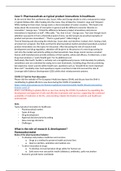Case 5: Pharmaceuticals as typical product innovations in healthcare
At the end of their first conference day, Susan, Mike and George decide to visit a restaurant to enjoy
a typical Maltese dish. After looking into the menu, they all take the ‘minestra’ soup and ‘timpana’.
While waiting for their meal, George starts a short evaluation of today’s sessions. “We heard a lot
today about the economics of innovation in general and the different economic theories on
innovation”, George says. “I think the difference between product innovations and process
innovations is important as well”, Mike adds. “Yes, that is true”, George says, “but even though much
attention was paid to it from a theoretical point of view, we did not get any practical examples of
product and process innovations”. “That is a good point”, Mike brings in.
Tired of listening and discussing the whole day, Susan does not interfere. Instead, she is having a look
at tomorrow’s program. She finds out that the pharmaceutical market and pharmaceuticals as typical
product innovations are the topics for discussion. After discussing the role of research and
development and drug regulation, attention will be given to the process of a new drug coming (or
not) into the market and priority setting in pharmaceuticals. New drugs cannot receive a product
license until manufacturers provide evidence of their quality, safety and efficacy. Furthermore, a new
drug must produce a “useful health gain” for its additional cost.
Particularly this fourth ‘hurdle’ is certainly not a straightforward process. Unfortunately for patients,
sometimes costs are contained by saying no to new treatments, including drugs that are promising
but expensive. Given scarcity within health care, questions such as “should life be more important
than cost?” inevitably arise. Such questions require countries to take into account the role of
Coverage with Evidence Development (CED) within their reimbursement systems.
COVID-19 Task for Post-discussion
Please visit the website of The European Medicines Agency (EMA) and discuss how the EMA is
contributing to global efforts to save lives during the COVID-19 pandemic.
https://www.ema.europa.eu/en/human-regulatory/overview/public-health-threats/coronavirus-
disease-covid-19
EMA is contributing to global efforts so save lives during the COVID-19 pandemic by expediting the
development and approval of safe and effective treatments and vaccines, supporting the continued
availability of medicines in the EU, and providing reliable information to patients and healthcare
professionals.
Aims
Typical product innovation in healthcare
- Pharmaceutical market
- Types of drugs
- Drug development
- Approval decisions/priority setting
- New coverage decisions
- Challenges
What is the role of research & development?
Pharmaceutical market
Roles of the pharmaceutical industry
- To develop and produce medicines and vaccines
o Drugs as a method to preserve health and save lives
o Next to nutrition, sanitation and medical care
- To drive innovation in drugs
o To develop, test and produce drugs safety for human use
o Early years very successful: insulin (diabetes), antibiotics, polio vaccination
- Economic growth factor worldwide
, o A lot of people work in this industry
Pharmaceutical expenditures
- Spending on pharmaceuticals account for a significant proportion of total health spending in
European countries
- Increased consumption of pharmaceuticals due to the introduction of new drugs and the
aging of populations
- Reforms in pharmaceutical market (for more efficiency)
- Around 60% of drug spending is publicly financed on average across OECD countries (18%
Bulgaria – 90% UK (2011))
Characteristics of the pharmaceutical market
- Multinational enterprises
o Mergers and acquisitions
- Barriers to entry by the protection of product by patents
o Monopoly position
o Research and development expenditures
- High willingness to pay for drugs
o Price regulation
o Often reimbursement in whole or in part by insurance
- More regulation in drug development
o Starting point: drug for sleeping (1960) cure morning sickness in pregnant women
problems for the fetus malformations in babies
- Product uncertainty
o New coverage decisions
- Aggressive advertisement (towards physicians) and government bans for end of users
o Detailing activity to doctors (a sales representative visits a doctor to discuss the
characteristics of a specific drug)
o Brochures in doctors’ office, advertising in medical journals, etc.
- With prescription from a physician
Government interventions: some examples
- Drug development regulation (clinical trials)
- Entry barriers – without patent protection, no innovation
- Drug price regulation (formularies)
- Ban on advertisement
- Specific regulations by example for orphan drugs
- Reimbursement/access: co-payment, generics
Type of drugs
- Ethical (or prescription) drugs: a licensed medicine that is regulated by legislation to require
a prescription before it can be obtained
- Over the counter drugs: medicines that may be sold without a prescription (e.g. aspirin)
- Brand drug: a drug which is produced and distributed with patent protection
- Generic drug (generics): a drug which is produced and distributed without patent protection
o A generic medicine contains the same active substance(s) as the reference medicine,
and it is used at the same dose(s) to treat the same disease(s). However, a generic
medicine’s inactive ingredients, name, appearance and packaging can be different
o Generic medicines are manufactured according to the same quality standards as all
other medicines (EMA)
o Opportunity to increase efficiency in pharmaceutical market





